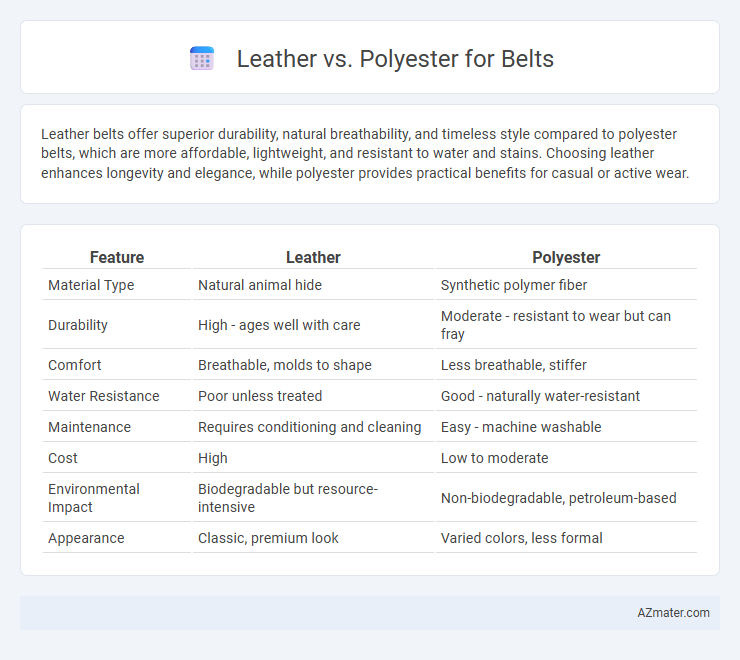Leather belts offer superior durability, natural breathability, and timeless style compared to polyester belts, which are more affordable, lightweight, and resistant to water and stains. Choosing leather enhances longevity and elegance, while polyester provides practical benefits for casual or active wear.
Table of Comparison
| Feature | Leather | Polyester |
|---|---|---|
| Material Type | Natural animal hide | Synthetic polymer fiber |
| Durability | High - ages well with care | Moderate - resistant to wear but can fray |
| Comfort | Breathable, molds to shape | Less breathable, stiffer |
| Water Resistance | Poor unless treated | Good - naturally water-resistant |
| Maintenance | Requires conditioning and cleaning | Easy - machine washable |
| Cost | High | Low to moderate |
| Environmental Impact | Biodegradable but resource-intensive | Non-biodegradable, petroleum-based |
| Appearance | Classic, premium look | Varied colors, less formal |
Introduction to Leather and Polyester Belts
Leather belts, crafted from animal hides such as cowhide, offer durability, flexibility, and a classic, timeless aesthetic favored for formal and casual wear. Polyester belts are made from synthetic fibers, known for their lightweight, water-resistant properties, and vibrant color retention, making them ideal for active or budget-conscious consumers. Both materials provide unique benefits, with leather emphasizing natural texture and longevity, while polyester excels in affordability and weather resistance.
Material Composition: Leather vs Polyester
Leather belts are made from natural animal hides, primarily cowhide, offering durability, breathability, and a luxurious texture that improves with age. Polyester belts consist of synthetic fibers derived from petroleum, providing resistance to stretching, moisture, and stains while maintaining lightweight flexibility. The choice between leather and polyester depends on preferences for natural material aesthetics and longevity versus synthetic durability and easy maintenance.
Durability and Longevity Comparison
Leather belts are known for their exceptional durability and ability to develop a unique patina over time, often lasting many years with proper care. Polyester belts offer high resistance to stretching, moisture, and abrasion, making them suitable for everyday use in active or outdoor environments. While leather belts typically provide longer longevity with a classic aesthetic, polyester belts excel in maintaining structural integrity under harsh conditions.
Comfort and Wearability Factors
Leather belts offer superior breathability and mold to the wearer's body over time, enhancing comfort through natural flexibility and moisture absorption. Polyester belts provide lightweight durability and resistance to stretching or fading, maintaining wearability in high-moisture or active conditions. While leather excels in long-term comfort and classic aesthetics, polyester delivers consistent performance and ease of maintenance in various environments.
Style and Aesthetic Appeal
Leather belts offer a timeless, sophisticated style with a natural texture and rich color variations that enhance formal and casual outfits alike. Polyester belts provide a sleek, modern look with vibrant colors and patterns, ideal for fashion-forward or sporty aesthetics. Leather's durability develops a unique patina over time, while polyester maintains consistent appearance with minimal wear.
Maintenance and Care Requirements
Leather belts require regular conditioning with leather-specific oils or creams to maintain suppleness and prevent cracking, and they should be kept away from excessive moisture and direct heat to avoid damage. Polyester belts demand less intensive care, as they are more resistant to water, stains, and wrinkles, typically needing only occasional spot cleaning with mild detergent. Proper storage, such as hanging leather belts and keeping polyester belts folded or rolled, helps extend the lifespan of both materials.
Environmental Impact and Sustainability
Leather belts have a significant environmental footprint due to livestock farming's high greenhouse gas emissions, water consumption, and land use, alongside the toxic chemicals involved in tanning. Polyester belts, derived from petroleum, rely on non-renewable fossil fuels and contribute to microplastic pollution, but they require less water and land compared to leather production. Sustainable alternatives often include vegetable-tanned leather or recycled polyester, balancing durability with reduced ecological damage.
Cost Effectiveness and Price Range
Leather belts typically range from $30 to $150, offering durability and a classic appearance that justifies their higher price through long-term use. Polyester belts are generally priced between $10 and $40, providing a budget-friendly option with decent resistance to wear but lower longevity compared to leather. The cost effectiveness of polyester belts suits short-term use or fashion variety, while leather belts deliver better value over time due to their sturdiness and timeless style.
Best Uses and Suitability
Leather belts offer superior durability and classic style, making them ideal for formal occasions and professional settings where appearance and longevity matter most. Polyester belts are lightweight, moisture-resistant, and often more affordable, perfect for casual wear, outdoor activities, and sports where flexibility and easy maintenance are prioritized. Choosing between leather and polyester belts depends on the desired balance between elegance and practicality for specific use cases.
Which Belt Material Is Right for You?
Leather belts offer durability, classic style, and natural breathability, making them ideal for formal wear and long-term use. Polyester belts provide lightweight, water-resistant, and affordable alternatives well-suited for casual or active lifestyles. Choosing the right belt material depends on your daily activities, desired aesthetic, and maintenance preferences.

Infographic: Leather vs Polyester for Belt
 azmater.com
azmater.com